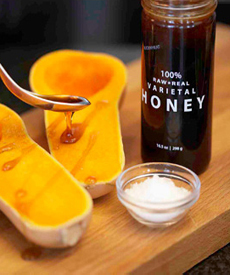TIP OF THE DAY: Honey & Food Pairings
 Based on the plant from which the pollen is harvested, each varietal honey has a distinctive flavor and color. Photo courtesy National Honey Board. |
Mass produced “supermarket honey” is blended specifically to have a generic flavor. As with table sugar, it delivers a uniform, sweet, simple taste to consumers time after time. But raw varietal honey—varietal referring to the variety of plant from which it was derived—can be compared to wine, tea and coffee in its character and complexity. Different varietals produce different flavors (and colors, too). As wine aficionados pair different flavors of wines with specific foods, so do honey sophisticates. The pairings can be revelations, similar to discovering how well a fruity red wine goes with grilled salmon. The pairings below were developed by Zeke Freeman of Bee Raw Honey, using his American honey varietals. They just beg to be served at a honey-pairing brunch. You may find other pairings you like even better. Make a party of it! And check out the recipes at Bee Raw Honey, which recommend, among other ideas, blueberry honey for glazed carrots, buckwheat honey for salmon fillets and orange blossom honey for a chicken or turkey glaze. Basswood Honey Basswood honey is light in color, delicate and mild, with warm herbal notes and a clean finish. |
|
|
Black Sage Honey Golden in color, black sage honey is mild, with a mouth-warming hint of pepper and a smooth clean finish. A medium amber in color, blueberry honey is strong and sweet, with earthy components. You can tell from the deep brown color that this honey is a different experience from the “simple sweetness” most people expect. Strongly-flavored like sorghum or molasses, this honey has hints of mossy earth, malty notes and less sweetness in general. |
||
|
Clover Honey
Lighter yellow in hue, delicate, sweet and buttery, a top yellow clover honey can deliver warm undertones of cinnamon and nutmeg. True to its floral source, this medium amber honey has a delicate cranberry aroma and amildly tart flavor with subtle floral hints and a light, fruity finish. |
 Stout and complex buckwheat honey, with earthy notes like sorghum or molasses, pairs nicely with sweet butternut squash. Photo courtesy BeeRaw.com. |
|
|
Orange Blossom Honey The light amber color and subtle flavor notes of citrus are a hint that you’re enjoying orange blossom honey. Light amber-hued raspberry honey is delicate and floral with a raspberry finish. Sourwood honey is dark amber: highly floral, rich and buttery with a maple finish. One of the palest gold honeys, yet thick and creamy, star thistle honey has soft notes of cinnamon and a long, sweet finish. Honey was treated as a fine edible in ancient Egypt, with its terroir noted on each honey vessel. How did it become a product of simple, sticky sweetness? As with much of the food in our culture, our palates have become dulled by over-salted, over-sweetened, processed food. Since producing and harvesting honey is extremely labor intensive; one worker honey bee makes just 1/12 of a teaspoon of honey in her lifetime! So producers give most consumers what they want—an acceptable price, as opposed to superior quality. Some honey isn’t even 100% honey, but has been cut and extended with fillers to keep the price down. Pick up a copy of The Honey Connoisseur: Selecting, Tasting, and Pairing Honey, With a Guide to More Than 30 Varietals. And if you’re a honey fan, start to look at honey the way you look at wine: Spend less on the honey you use in baking or cooking, spend more on the honey you enjoy on a piece of toast. Each region is known for honey derived from their local crops: blueberry honey from Maine, lavender honey from Provence (France), orange blossom honey from Florida, sourwood honey from Georgia. Check out farmers markets and specialty food stores that let you taste different honeys. You’ll find herbal, floral, spicy, tart and other nuances that will sing to you. |
||


